21 CFR Part 11
Total Confidence. Absolute Integrity.
Total Confidence. Absolute Integrity.
Data integrity is vital during the drug development process as it directly impacts patient safety, regulatory compliance, and scientific credibility.
Drug development relies on accurate, complete, and consistent data to determine the optimal formulation, dosage, and safety profile of a drug. Any error or manipulation in data can lead to ineffective or harmful products reaching patients. For this reason, regulatory bodies, like the U.S. Food and Drug Administration (FDA) and European Medicines Agency (EMA), require strict adherence to data integrity standards under GxP (Good Manufacturing, Clinical, and Laboratory Practices).
Furthermore, reliable data helps with early identification and resolution of issues, reducing costs, delays, and rework.
As companies shift from paper-based to electronic systems, there is a need for regulatory frameworks to ensure that electronic records are trustworthy and secure.
21 CFR Part 11 is a regulation issued by the FDA that establishes requirements for electronic records and electronic signatures in regulated industries. This includes pharmaceuticals, biologics, medical devices, and food products (human and veterinary). Companies in these industries that do business in the United States, as well as providers of raw materials and components to pharmaceutical companies and contract labs commissioned to perform analysis work, must all operate to ensure that electronic records and electronic signatures are trustworthy and reliable.
Key requirements of 21 CFR Part 11:
21 CFR Part 11 is designed to protect the safety of consumers by ensuring the accuracy and reliability of electronic records and electronic signatures. By complying with these requirements, companies can help to ensure that their products are safe and effective.
While 21 CFR Part 11 provides the legal and technical framework, ALCOA++ principles provide the practical and ethical foundation for how data should be handled.
Click on each icon to explore the ways OmniTrust can help your workflow conform to ALCOA++ principles:
Attributable
Data is attributable to the person and/or system generating the data.
Legible
Data is maintained in a readable form to allow review in its original context.
Contemporaneous
Data is generated by a system or captured by a person at the time of the observation, and the time point of the observation and storage should is kept as part of the metadata.
Original
Data is the original first generation/capture of the observation or certified copy.
Accurate
Data is an accurate representation of the observations made. The use of computerised systems ensures that the data are at least as accurate as those recorded on paper.
Complete
Data is a complete representation of the observation made, including test repeats and/or reanalysis, to allow to reconstruct and fully understand an event.
Consistent
Data definition, generation/capturing and management is consistent and void of contradictions throughout the data life cycle.
Enduring
Data is maintained appropriately such that they remain intact and durable through the entire data life cycle.
Available
Data is stored throughout the data life cycle and is readily available for review when needed.
Traceable
Any changes to the data, context/metadata are traceable, explained and documented.
USP <1058> Analytical Instrument Qualification (AIQ), is a general chapter in the United States Pharmacopeia that provides a structured framework for ensuring that analytical instruments are suitable for their intended use in regulated laboratories.
It defines the qualification process for analytical instruments used in pharmaceutical testing, based on four stages of qualification. Its goal is to ensure that instruments consistently produce accurate, reliable, and reproducible results.
Four stages of qualification USP <1058>:
Similarly, the EU GMP Annex 15 is the section of the European Union's Good Manufacturing Practice (GMP) guidelines that specifically addresses qualification and validation in the manufacturing of medicinal products. The principles are focused on the same four stages of qualification outlined in USP <1058> and it emphasizes a lifecycle approach to validation, including planning, execution, and maintenance.
While USP <1058> and Annex 15 ensures instruments produce valid data, 21 CFR Part 11 and related data integrity regulations ensure that data is securely managed. Together they play a foundational role in ensuring data integrity and regulatory compliance.
Find more about Analytical instrument qualification here.
Developed by Malvern Panalytical, OmniTrust is a flexible, scalable, and multi-instrument solution that can be tailored to meet the specific needs of your organization. Designed to enhance data integrity and streamline compliance, it provides the tools you need to meet evolving regulatory demands with confidence.
OmniTrust supports 21 CFR Part 11 compliance through a comprehensive offering that combines software and expert services. It helps ensure the authenticity, integrity, and confidentiality of electronic records and signatures, while also supporting validation efforts and the implementation of robust operational and procedural controls, delivering end-to-end regulatory compliance.

Our software, including our OmniTrust package, enables the products shown in the table below (alongside appropriate local IT infrastructure) to be compliant with the following regulations and guidance:
Learn more about the Malvern Panalytical instruments and software that meet these requirements below.
| Product | 21 CFR Part 11 Compliant Software |
|---|---|
| Aeris | Aeris Instrument Suite
OmniTrust (OmniAccess and OmniTrail) Data Collector version 7.x Data Viewer version 2.x HighScore (Plus) version 5.x |
| Empyrean | Empyrean XRD Suite
OmniTrust (OmniAccess and OmniTrail) Data Collector version 7.x Data Viewer version 2.x HighScore (Plus) version 5.x |
| Mastersizer | OmniTrust (OmniAccess and OmniTrail)
Mastersizer Xplorer |
| X’pert3 | Data Collector version 7.x
Data Viewer version 2.x HighScore (Plus) version 5.x |
| Zetasizer Advance | OmniTrust (OmniAccess and OmniTrail)
ZSXplorer 2.x |
| NanoSight Pro | OmniTrust (OmniAccess and OmniTrail)
NS Xplorer 2.x |
| Zetium | Zetium Software |
| MicroCal DSC | Microcal DSC Software
Malvern Access Configurator |
|
Epsilon 1
Epsilon 4 |
Epsilon Software |
|
Morphologi 4
Morphologi 4-ID |
Morphologi Software |
| OMNISEC | OMNISEC Software
Malvern Access Configurator |
| Spraytec | Spraytec 2.x (and above) |

